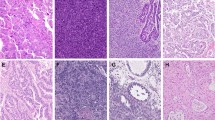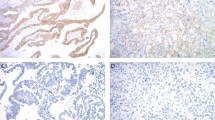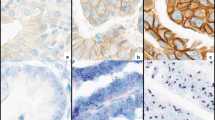Abstract
HERG K+channels, besides contributing to regulate cardiac and neuronal excitability, are preferentially expressed in tumour cell lines of different histogenesis, where their role in the development and maintenance of the neoplastic phenotype is under study. We show here that both herg gene and HERG protein are expressed with high frequency in primary human endometrial cancers, as compared to normal and hyperplastic endometrium. RT-PCR and immunohistochemistry, using specific anti-HERG antibodies developed in our laboratory, were applied to tissue specimens obtained from 18 endometrial cancers and 11 non-cancerous endometrial tissues. herg RNA and HERG protein are expressed in 67% and 82%, respectively, of cancerous, while in only 18% of non-cancerous tissues. In particular, no expression was found in endometrial hyperplasia. Moreover, electrophysiological experiments confirmed the presence of functioning HERG channels on the plasma membrane of tumour cells. On the whole, these data are the first demonstration of the presence of HERG channels in primary human neoplasias, and could candidate HERG as a potential tool capable of marking cancerous versus hyperplastic endometrial growth. © 2000 Cancer Research Campaign http://www.bjcancer.com
Similar content being viewed by others
Article PDF
Change history
16 November 2011
This paper was modified 12 months after initial publication to switch to Creative Commons licence terms, as noted at publication
References
Arcangeli A, Becchetti A, Mannini A, Mugnai G, DeFilippi P, Tarone G, DelBene MR, Barletta E, Wanke E and Olivotto M (1993) Integrin mediated neurite outgrowth in neuroblastoma cells depends on the activation of potassium channels. J Cell Biol 122: 1131–1143
Arcangeli A, Bianchi L, Becchetti A, Faravelli L, Coronnello M, Mini E, Olivotto M and Wanke E (1995) A novel inward-rectifying K+current with a cell cycle dependence governs the resting potential of mammalian neuroblastoma cells. J Physiol 489: 455–471
Arcangeli A, Rosati B, Cherubini A, Crociani O, Fontana L, Ziller C, Wanke E and Olivotto M (1997) HERG and IRK-like inward rectifier currents are sequentially expressed during neuronal development of neural crest cells and their derivatives. Eur J Neurosci 9: 2596–2604
Arcangeli A, Rosati B, Cherubini A, Crociani O, Fontana L, Passani B, Wanke E and Olivotto M (1998) Long term exposure to Retinoic Acid induces the expression of IRKI channels in HERG channel-endowed neuroblastoma cells. Biochem Biophys Res Commun 244: 706–711
Arcangeli A, Rosati B, Crociani O, Cherubini A, Fontana L, Passani B, Wanke E and Olivotto M (1999) Modulation of HERG current and herg gene expression during Retinoic Acid treatment of human neuroblastoma cells: potentiating effects of BDNF. J Neurobiol 40: 214–225
Argentieri TM, Kulik J, DeGennaro LJ, Spinelli W and Colatsky TJ (1998) Inhibition of cardiac delayed rectifier K+current by overexpression of the Long-QT Syndrome HERG G628S muation in transgenic mice. Circ Res 83: 668–678
Babij P, Askew GR, Nienwenhuijsen B, Su CM, Bridal TR, Jow B, Zhou Z, Gong Q, Epstein ML and Janary CT (1998) HERG channel disfunction in human Long-QT syndrome. J Biol Chem 273: 21061–21066
Backer VV (1996) The molecular biology of endometrial adenocarcinoma. Clin Obstetr Gynecol 39: 707–715
Berchuck A and Boyd J (1995) Molecular basis of endometrial cancer. Cancer (Phila.) 76: 2034–2040
Bianchi L, Wible B, Arcangeli A, Taglialatela M, Morra F, Castaldo P, Crociani O, Rosati B, Faravelli L, Olivotto M and Wanke E (1998) herg encodes a K+current highly conserved in tumors of different histogenesis: a selective advantage for cancer cells?. Cancer Res 58: 815–822
Binggeli R and Weinstein RC (1986) Membrane potentials and sodium channels: hypotheses for growth regulation and cancer formation based on changes in sodium channels and gap junctions. J Theor Biol 123: 377–401
Burks RT, Kessis TD, Cho KR and Hedrick L (1994) Microsatellite instability in endometrial carcinoma. Oncogene 9: 1163–1166
Burton JL and Wells M (1998) Recent advances in the histopathology and molecular pathology of carcinoma of the endometrium. Histopathology 33: 297–303
Chatzaki E, Gallagher CJ, Iles RK, Ind TEJ, Nouri AME, Bax CMR and Grudzinskas JG (1994) Characterization of the differential expression of marker antigens by normal and malignant endometrial epithelium. Br J Cancer 69: 1010–1014
Chiesa N, Rosati B, Arcangeli A, Olivotto M and Wanke E (1997) A novel role for HERG K+channels: spike-frequency adaptation. J Physiol 501: 313–318
Creasman WT (1993) Prognostic significance of hormone receptors in endometrial cancer. Cancer 71: 1467–1470
Faravelli L, Arcangeli A, Olivotto M and Wanke E (1996) A HERG-like K+channel in rat F-11 DRG cell line: pharmacological identification and biophysical characterization. J Physiol 496: 13–23
Hamill OP, Marty A, Neher E, Sakmann F and Sigworth FJ (1981) Improved patch-clamp techniques for high resolution current recording from cells and cell-free membrane patches. Pfluegers Arch 391: 85–100
Kohler MF, Nishii H, Humphrey PA, Saski H, Marks J, Bast RC, Clarke-Pearson DL, Boyd J and Berchuck A (1993) Mutation of the p53 tumor-suppressor gene is not a feature of endometrial hyperplasia. Am J Obstet Gynecol 169: 690–694
Li X, Xu J and Li M (1997) The human Δ1261 mutation of the HERG potassium channel results in a truncated protein that contains a subunit interaction domain and decreases the channel expression. J Biol Chem 272: 705–708
Maniatis T, Fritsh EF and Sambrook J (1989) Molecular cloning: a laboratory manual. Cold Spring Harbor Laboratory, Cold Spring Harbor, New York
Milatovich A, Heerema NA and Palmer CG (1990) Cytogenetic studies of endometrial malignancies. Cancer Genet Cytogenet 46: 41–53
Olivotto M, Arcangeli A, Carlà M and Wanke E (1996) Electric fields at the plasma membrane level: a neglected element in the mechanism of cell signalling. BioEssays 18: 495–504
Pardo LA, Dela Camino D, Sanchez A, Alves F, Brueggemann A, Beckh S and Stuehmer W (1999) Oncogenic potential of EAG K+channels. EMBO J 18( 20):5540–5547
Petrecca K, Atanasiu R, Akhavan A and Shrier A (1999) N-linked glycosylation sites determine HERG channel surface membrane expression. J Physiol 515: 41–48
Pond AL, Scheve BK, Benedict AT, Petrecca K, Van Wagoner DR, Shrier AS and Nerbonne JM (2000) Expression of distinct ERG proteins in rat, mouse and human heart. J Biol Chem 275: 5997–6006
Porter PL, Gown AM, Kramp SG and Coltrera MD (1992) Widespread p53 overexpression in human malignant tumours: an immunohistochemical study using metharcan-fixed, embedded tissue. Am J Pathol 140: 145–153
Risinger JI, Berchuck A, Kohler MF, Watson P, Lynch HT and Boyd J (1993) Genetic instability of microsatellites in endometrial carcinoma. Cancer Res 53: 5100–5103
Rosati B, Arcangeli A, Cuccuru D, Crociani O, Lecchi M, Olivotto M and Wanke E (1998) Novel properties of ERG K+channels in pituitary cells. SFN Annu Meet 330: 17 (abstr.)
Sanguinetti MC, Jiang C, Curran ME and Keating MT (1995) A mechanistic link between an inherited and an acquired cardiac arrhythmia: HERG encodes the IKr potassium channel. Cell 81: 299–307
Taskin M, Lallas TA, Barber HRK and Shevchuck MM (1997) bcl-2 and p53 in endometrial adenocarcinoma. Mod Pathol 10: 728–734
Taylor-Papadimitriou J and Epenetos AA (1994) Exploiting altered glycosylation patterns in cancer: progress and challenges in diagnosis and therapy. Trends Biotechnol 12: 227–233
Warmke JW and Ganetzky B (1994) A family of potassium channel genes related to eag in Drosophila and mammals. Proc Natl Acad Sci USA 91: 3438–3442
Zhou Z, Gong Q, Epstein ML and Janary CT (1998) HERG channel disfunction in human long QT syndrome. J Biol Chem 273: 21061–21066
Author information
Authors and Affiliations
Rights and permissions
From twelve months after its original publication, this work is licensed under the Creative Commons Attribution-NonCommercial-Share Alike 3.0 Unported License. To view a copy of this license, visit http://creativecommons.org/licenses/by-nc-sa/3.0/
About this article
Cite this article
Cherubini, A., Taddei, G., Crociani, O. et al. HERG potassium channels are more frequently expressed in human endometrial cancer as compared to non-cancerous endometrium. Br J Cancer 83, 1722–1729 (2000). https://doi.org/10.1054/bjoc.2000.1497
Received:
Revised:
Accepted:
Published:
Issue date:
DOI: https://doi.org/10.1054/bjoc.2000.1497
Keywords
This article is cited by
-
The role of potassium channels in the proliferation and migration of endometrial adenocarcinoma HEC1-A cells
Molecular Biology Reports (2022)
-
Transgenic mice overexpressing the LH receptor in the female reproductive system spontaneously develop endometrial tumour masses
Scientific Reports (2021)
-
HERG1A potassium channel is the predominant isoform in head and neck squamous cell carcinomas: evidence for regulation by epigenetic mechanisms
Scientific Reports (2016)
-
Potassium channel activation inhibits proliferation of breast cancer cells by activating a senescence program
Cell Death & Disease (2013)
-
hERG channel function: beyond long QT
Acta Pharmacologica Sinica (2013)



